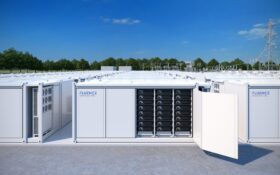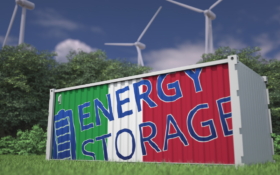Dipak Sen Choudhury reports how leading Indian businesses have hydrogen on their energy storage radar.

Between now and 2050 India’s per capita income is projected to grow 10-fold. The country’s economy, estimated at approximately $3.5 trillion in 2022 is expected to double by 2030 and exceed $7 trillion. Between 2030 and 2050 this figure is forecast to grow by a staggering factor of four reaching somewhere close to $30 trillion.
Now, consider the fact that India has a very young population – the average age is lower than that for most other countries. The country has a large portion of the entire population being of working age. This and the demographic dividend will for decades ensure India boasts the largest and youngest middle class on the globe with an almost insatiable need of energy to support their highly evolved lifestyle.
Energy security is therefore crucial in the minds of India’s policy-makers as a very large percentage of all the energy needs of the country is currently based on fossil fuels – coal and petroleum, with the latter mostly imported.
Imported oil a major drag
Importing oil is not only a major drag on the economy but, more importantly, it is largely sourced from countries with whom the Indian government does not have a feeling of trust – except Russia perhaps, which in any case has other ramifications. The business relationships with Gulf countries are very transactional and based on mutual necessity and better be done away with if options become available.
It is against this background that India’s interest and investment in hydrogen as the ultimate energy source is to be looked at and evaluated. India has no dearth of renewable energy sources – solar and wind, and solar power generation tariffs have been driven well below fossil-fuel tariffs, with only distribution remaining a challenge.
What if an intense engagement diving into the depth of green hydrogen generation is able to take the cost to around $1 per kg, from the current $4–5? Together with similar breakthroughs in cost reduction of hydrogen turbines and fuel cells, the Indian economy could free herself from the era of oil imports and deliver a solid boost to the country, both economically and politically. The entire energy source of the country would be indigenous and, not only that, India could also become a net energy exporter by sending hydrogen to interested countries.
National Hydrogen Mission
Technically, the above is quite possible. The dates may be a little extended but can be reached eventually. This has spurred Prime Minister Narendra Modi to announce the National Hydrogen Mission on behalf of the government.
So, to complete the energy storage story of India it is necessary to understand that the plan goes slightly beyond storage. It looks at a new energy generation – storage paradigm – a large-scale shift to hydrogen. Almost on cue, two of India’s largest corporate houses, the Adanis and Ambanis, have both unveiled grand plans of ushering in the hydrogen-based economy.
The Adanis hail from the state of Gujarat, the home state of Prime Minister Modi. They have diverse business interests across the country covering seaports and logistics, private airports, cement manufacturing, thermal power generation, city gas supplies and, finally, what is claimed as India’s largest renewable power company. The scion of the Adani family, Gautam Adani, has personal wealth that flits in and out amongst the top 20 of the global billionaires.
The Adani group is investing heavily in renewable energy, tripling its solar capacity over next four years and tripling its wind power generation to a significant extent too. In terms of total renewable generation, the company is set to become the world’s largest in renewable energy generation by 2030.
In tandem, the Adani group plans to implement a million tons of green hydrogen generation by 2027. Investments already exceed $2.5 billion and are mostly directed in building up the backward integrated value chain covering solar, wind, electrolysers, and allied equipment. There is an overall objective of generating green hydrogen at lowest cost. The plan is to achieve a capacity of three million tons of hydrogen generation 10 years from now with an overall investment of $50 billion.

The Ambanis eye new energy
The other family, also from the state of Gujarat, are the Ambanis of the famed Reliance Group. They have extensive interests in petrochemicals, telecommunication, retail and now identified ‘new energy’ as their primary focus point for the coming decade.
It is reported that Mukesh Ambani, the man at the top, has divested his responsibilities towards all his running and well established businesses by setting up his children as CEOs of the various units, keeping himself free to devote his full attention to the new energy business only.
The Ambanis like to do things in a very grand style, and to tell people about it. Some of the best brains of the world in related fields have been engaged as the ‘New Energy Advisory Council’ and the work has been planned out on the following aspects. Reliance also likes to set very difficult performance targets, which normally change the rules of the game in the industry and excel in achieving the same. For the overall energy-environment perspective their target is to achieve net-zero status by 2035.
The company literature explains that their business will be based on the principle of carbon recycling and a circular economy, with a portfolio of advanced and speciality materials. The aim is to create a fully integrated manufacturing ecosystem with secure and self-sufficient supply chains. The vision is to address India’s energy trilemma – affordability, sustainability, security – with production of green energy. Investment totals $8 billion, in five distinct buckets:
- fully integrated solar photovoltaic manufacturing complex
- fuel cell system
- green hydrogen, with fully indigenous super-efficient electrolysers
- energy storage – electrochemical cell, pack, module manufacture
- power electronics and semiconductor development.
The entire facility will be in a single site spread over 5,000 acres of land. Central to the success of the initiative is emphasis on developing basic raw material and auxiliary materials manufacturing. The company has an additional $2.5 billion investment set aside for investments in value chain, partnerships, and future technologies. These include upstream and downstream industries to create a fully integrated, end-to-end renewable energy ecosystem.
Gigafactory by 2026
Remaining with the more conventional electrical energy storage, Reliance is also in the process of setting up a battery gigafactory by 2026 for manufacturing battery chemicals, cells, and packs as well as containerised energy storage solution using the lithium iron phosphate technology platform. There is also a promise of migrating to sodium-ion technology as soon as it is ready for commercial deployment.
Green hydrogen at $1 per kg however remains as the era-defining aspiration of the group and towards this end the group is collaborating with Danish company Stiesdal on manufacturing their HydroGen electrolysers in India, which will produce hydrogen at significantly lower cost compared to current levels.
Given the government’s definite push towards hydrogen, some of the major state-owned companies like the utility giant NTPC and Indian Oil Corporation oil major, have their hydrogen plans. NTPC’s interest in different storage technology options has been previously discussed. Indian Oil has been rather focusing on hydrogen-fuelled mobility options.

Third family-owned business in energy
Amongst the other organisations in the private corporate sector active in the ESS activities in the country, mention may be made of JSW. It is the third family-owned business, traditionally in the fields of infrastructure sectors like steel and cement, which has forayed into energy. It has a significant interest in renewables with and without storage.
In fact, JSW won India’s first major competitive order released on ESS, floated by Solar Energy Centre of India (SECI), for the installation of 1GWh of storage at a single location in the state of Rajasthan. The company has strong plans and is targeting a total installed base of 5GW/40GWh of storage in the country by 2030.
Finally, to end the story of the Indian energy storage, mention must made of the strong presence of pumped hydro storage in the overall plans. It is already announced that the famous house of Tatas, the Adani group and JSW are at advanced negotiations for a total of 39GW of pumped storage at multiple locations across the country at a total cost of $40 billion. The state-owned NTPC, through its subsidiary National Hydel Power Corporation (NHPC), is also working out an elaborate infrastructure for setting up pumped storage at various locations.
The energy storage business in the country has just about reached the business end with a number of organisations firmly emerging as serious solution providers for the future. It is a large enough business that can accommodate any number of technologies and organisations from across the globe. It is an opportunity for all to come and grab a share of this nation-building exercise. All are considered welcome.












